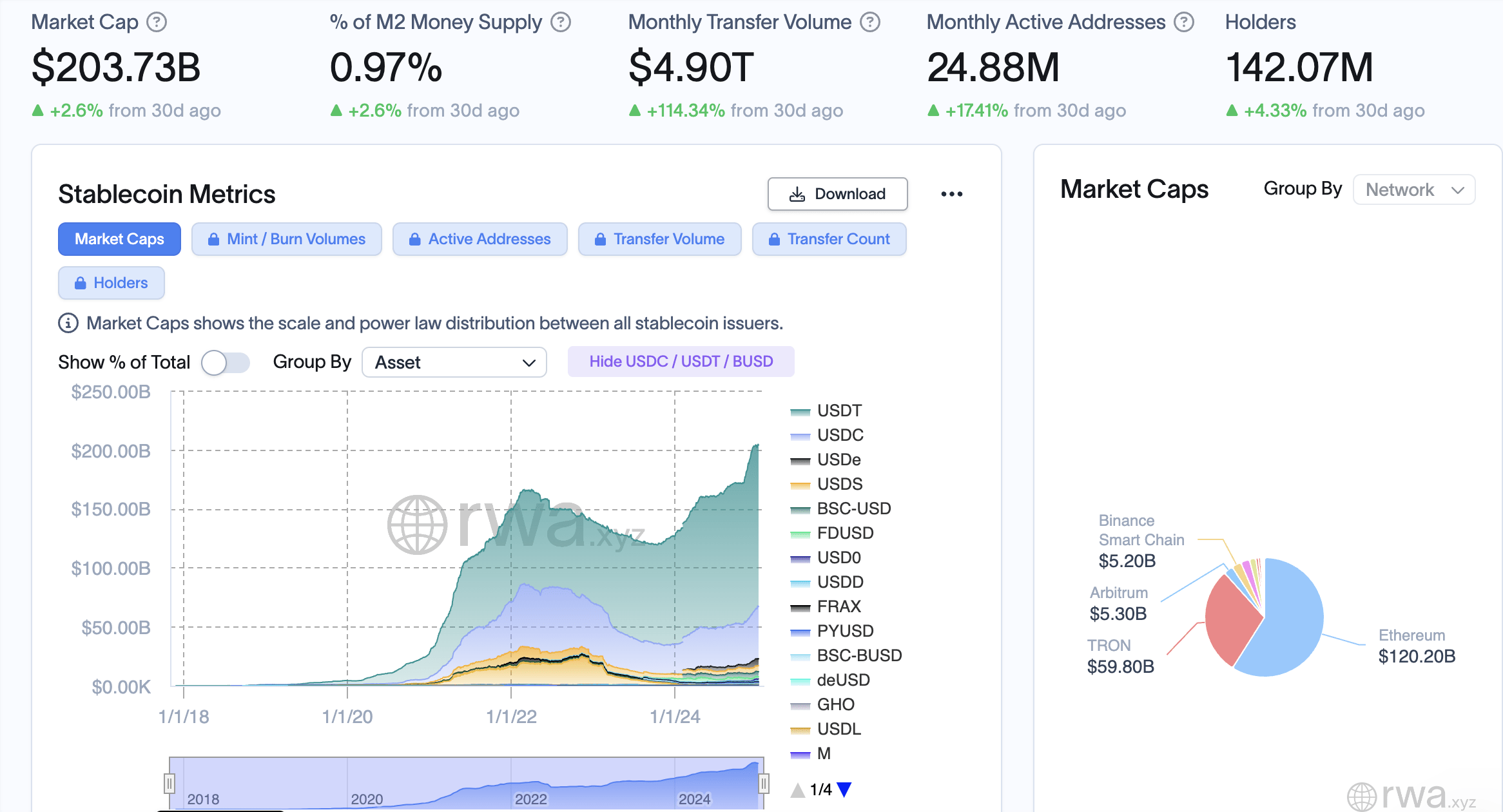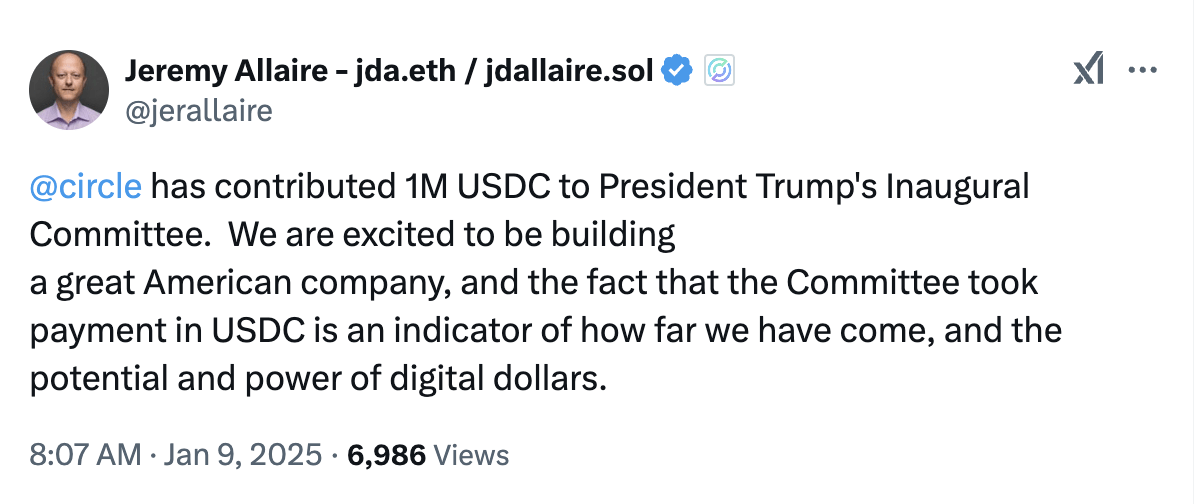FBI arrests Nigerian ‘tech queen’ Sapphire Egemasi in $1.3M heist targeting U.S. government
06/05/2025 - Updated On 06/17/2025
Stablecoin issuer Circle made a notable contribution to U.S. politics this week by donating 1 million USD Coin (USDC) to President-elect Donald Trump’s Inauguration Committee. The announcement, made by Circle CEO Jeremy Allaire on January 9, marks a key moment in the evolving role of stablecoins in global finance.
The Circle USDC donation, according to Allaire, underscores the maturation of the stablecoin industry and its increasing acceptance within traditional financial and political circles. “The acceptance of this donation is a strong signal that stablecoins like USDC are becoming mainstream financial instruments,” Allaire stated. “This move is not just a contribution to a political event, but a reflection of the growing influence of blockchain-based financial assets in the global economy.”
The Circle USDC donation comes at a time when stablecoins have seen significant growth. According to data from RWA.xyz, the total market capitalization of stablecoins is around $203 billion, with Circle’s USDC commanding a substantial $44 billion of this total. Stablecoins have increasingly become a staple of the broader cryptocurrency ecosystem, offering a reliable and overcollateralized alternative to more volatile digital assets like Bitcoin and Ethereum.
Stablecoin issuers like Circle and Tether, which together hold more than $120 billion in short-term U.S. government securities, are emerging as key players in the global economy. They are now collectively the 18th-largest buyers of U.S. government debt, according to recent financial reports. This positions stablecoin issuers as influential entities in the financial landscape, with their market presence continuing to grow.
The Circle USDC donation is just one of the latest examples of stablecoins gaining legitimacy in the eyes of lawmakers and the public. Stablecoins have become a central issue in the ongoing debate over cryptocurrency regulation in the United States. Industry executives have expressed optimism for the second Trump administration, anticipating a more favorable regulatory environment for digital assets, including stablecoins.
One key legislative effort aimed at regulating stablecoins is the Lummis-Gillibrand Payment Stablecoin Act, introduced in April 2024 by U.S. Senators Kirsten Gillibrand and Cynthia Lummis. The bill seeks to create a clear framework for the regulation of stablecoins, a move that industry insiders argue is essential to maintaining the U.S. dollar’s global dominance in the face of rising competition from digital assets.

Senator Gillibrand emphasized the importance of stablecoin regulation in a statement upon introducing the bill: “Passing a regulatory framework for stablecoins is absolutely critical to maintaining the U.S. dollar’s dominance in the global financial system. The U.S. must lead in digital finance innovation to secure its economic future.”
The Circle USDC donation also highlights the intersection between stablecoins and U.S. government debt. Stablecoin issuers, such as Circle and Tether, have become key investors in short-term U.S. government securities, including Treasury bills. Paul Ryan, the former Speaker of the House, penned an op-ed in June 2024 arguing that stablecoins could play a critical role in alleviating the U.S. national debt crisis. By driving demand for U.S. government debt, stablecoin issuers would help ensure the dollar remains the dominant global reserve currency.
In response to this growing influence, U.S. lawmakers are moving forward with legislation to create a clearer regulatory framework for stablecoins. In October 2024, Senator Bill Hagerty introduced the Clarity for Payment Stablecoins Act, which seeks to regulate stablecoin issuers based on their market capitalization. Smaller stablecoin issuers, those with less than $10 billion in market capitalization, would be regulated at the state level rather than federally.
As Circle’s donation to Trump’s Inauguration Committee demonstrates, the stablecoin market is evolving rapidly. Industry leaders are optimistic about the future of stablecoins, with many predicting significant growth in the coming years. Guy Young, the founder of the blockchain platform Ethena, recently forecasted that the stablecoin sector could reach a market capitalization of $300 billion by 2025. This growth will likely be driven by established players like Tether’s USDT and Circle’s USDC, which continue to dominate the market.

Deng Chao, CEO of the institutional asset management firm HashKey Capital, echoed this sentiment, noting that stablecoins are becoming one of the most attractive digital asset classes for venture capitalists. “Venture capitalists are increasingly focused on stablecoins in emerging market economies,” Chao explained. “Stablecoins have a proven use case in providing banking services to the unbanked, and we expect this demand to continue growing as global financial inclusion becomes a top priority.”
The Circle USDC donation to Trump’s Inauguration Committee reflects the broader trend of stablecoins becoming an integral part of the financial system. As lawmakers and industry leaders continue to push for regulatory clarity, the future of stablecoins appears bright. With their role in global finance continuing to expand, Circle’s contribution to Trump’s committee may serve as a pivotal moment in the ongoing evolution of digital assets.
The Circle USDC donation to Trump’s inauguration committee is not just a milestone for the company but a sign that stablecoins are becoming a more integral part of the broader financial landscape, with implications that reach far beyond the world of cryptocurrency.
Get more from The Bit Gazette